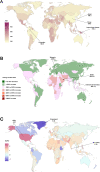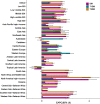Trends in the incidence of diabetes mellitus: results from the Global Burden of Disease Study 2017 and implications for diabetes mellitus prevention
- PMID: 32943028
- PMCID: PMC7500018
- DOI: 10.1186/s12889-020-09502-x
Trends in the incidence of diabetes mellitus: results from the Global Burden of Disease Study 2017 and implications for diabetes mellitus prevention
Abstract
Backgroud: Diabetes mellitus is a common chronic disease and a severe public health issue. The incidence trends for type 1 diabetes (TIDM) and type 2 diabetes (T2DM) have rarely been studied on a global scale. We aimed to determine the temporal and geographical trends of diabetes globally.
Methods: Data on diabetes mellitus, including incidence, prevalence from 1990 to 2017 were obtained from the 2017 Global Burden of Disease study. We calculated the estimated annual percentage changes (EAPCs) in age-standardized incidence rate (ASIR) of diabetes mellitus according to sex, region, and disease type.
Results: The worldwide incident cases of diabetes mellitus has increased by 102.9% from 11,303,084 cases in 1990 to 22,935,630 cases in 2017 worldwide, while the ASIR increased from 234 /100,000 persons (95% UI, 219-249) to 285/100,000 persons (95% UI, 262-310) in this period [EAPC = 0.87, 95% confidence interval (CI):0.79-0.96]. The global ASIRs of T1DM and T2DM both demonstrated significant increase during 1990-2017, with EAPCs of 0.34 (95% CI,0.30-0.39) and 0.89 (95% CI,0.80-0.97), respectively. The ASIR trends also varied considerably by regions and countries. The increase in ASIR was greatest in high sociodemographic index regions (EAPC = 1.05, 95% CI:0.92-1.17) and lowest in low-SDI regions (EAPC = 0.79, 95% CI:0.71-0.88).
Conclusions: Both the number of incident cases and ASIR of diabetes mellitus increased significantly during 1990-2017 worldwide, but the temporal trends varied markedly across regions and countries.
Keywords: Global diabetes mellitus; Incidence; Prevention; Trends.
Conflict of interest statement
The authors declare that they have no competing interests.
Figures






References
-
- Amos AF, McCarty DJ, Zimmet P. The rising global burden of diabetes and its complications: estimates and projections to the year 2010. Diabet Med. 1997;14(Suppl 5):S1–85. - PubMed
MeSH terms
Grants and funding
LinkOut - more resources
Full Text Sources
Medical

